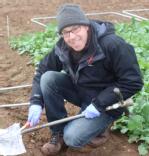Five things you need to know about soil
Soil: As children we learn that plants grow in it and worms live in it and that's generally as far as we go. But the mix of minerals, water, air, decaying plant and animal matter and countless microorganisms that make up the top layer of the earth's surface is hugely important, not only for plant life, but for all life on earth.
Here are five things you should know about soil:
1. We need to look after it
Soil is a finite resource which is vanishing quickly and is slow to be replenished: it takes 1000 years for an inch of topsoil to form. Our use of land for agriculture can make soils susceptible to degradation and loss, through processes such as erosion. The costs of soil degradation to society are estimated to be £1.4 billion a year in the UK alone. This reflects the loss of important functions such as water storage, which can result in rapid rises in river levels and flooding following heavy rainfall events. Soil degradation may get worse as climate change proceeds and the frequency of extreme rainfall events increases.
2. It’s good at storing carbon
The world’s soils lock up 90 gigatonnes of carbon (1 gigatonne= 109 tonnes), and more carbon is stored in this way than in the planet’s atmosphere or vegetation. If soil isn’t managed carefully, this carbon can be converted to carbon dioxide, contributing to global warming. Many modern farming practices stimulate this release of carbon, but we can help soil to retain its stores by changing the way we manage it. For example, we can reduce tillage and convert arable land to forest and grassland. This would help reverse climate change, but the rate of change in soil carbon is slow.
3. It’s like an infinite zoo full of microscopic aliens
Soil is home to a vast diversity of life forms, which interact in complex food webs. A gram of soil contains a billion bacteria and multitudes of other microbes such as viruses and fungi. The mass of living organisms in one hectare of soil is equivalent to five tonnes- that’s the weight of 100 sheep!
Soil microbes have provided us with numerous useful products, including many antibiotics. However, we still don’t know what most organisms that live in soil look like, or what they do. Advances in DNA sequencing technologies are allowing us to discover new types of microbe with potential value in biotechnology, agriculture and medicine. Just like the rainforest, the soil may hold the cure for cancer, the next antibiotic or a revolutionary treatment for a plant disease.
4. Soil microbes are vital for plant life
Most plants form mutually beneficial relationships with soil fungi. The plant provides the fungus with sugars, and in return the fungus provides essential nutrients and protection against pathogens. These partnerships are known as mycorrhizal symbioses, and are thought to have helped plants first colonise the planet. Fossil evidence shows that these fungi were present on the roots of the very earliest plants, which evolved 450 million years ago.
5. Soil microbes could help farmers
Gaining a better understanding of how soil microbes interact with plants will have benefits for agriculture. Microbes living on roots can interact with plants in many ways: some are plant pathogens, which kill or reduce the growth of plants, while others benefit their host by supporting plant growth. Learning how to manage these microbes and their benefits could help to make farming more sustainable, by reducing our reliance on pesticides and fertilisers.
Published:
3 December 2018
About:
 Professor Gary Bending is an environmental scientist whose research focuses on the structure and ecosystem functions of microbial communities.
Professor Gary Bending is an environmental scientist whose research focuses on the structure and ecosystem functions of microbial communities.
 Amy Newman is a doctoral research student investigating the changes throughout the day in the structure and function of the microbial communities present in the root zone.
Amy Newman is a doctoral research student investigating the changes throughout the day in the structure and function of the microbial communities present in the root zone.
Terms for republishing
The text in this article is licensed under a Creative Commons Attribution 4.0 International License (CC BY 4.0).
Share


